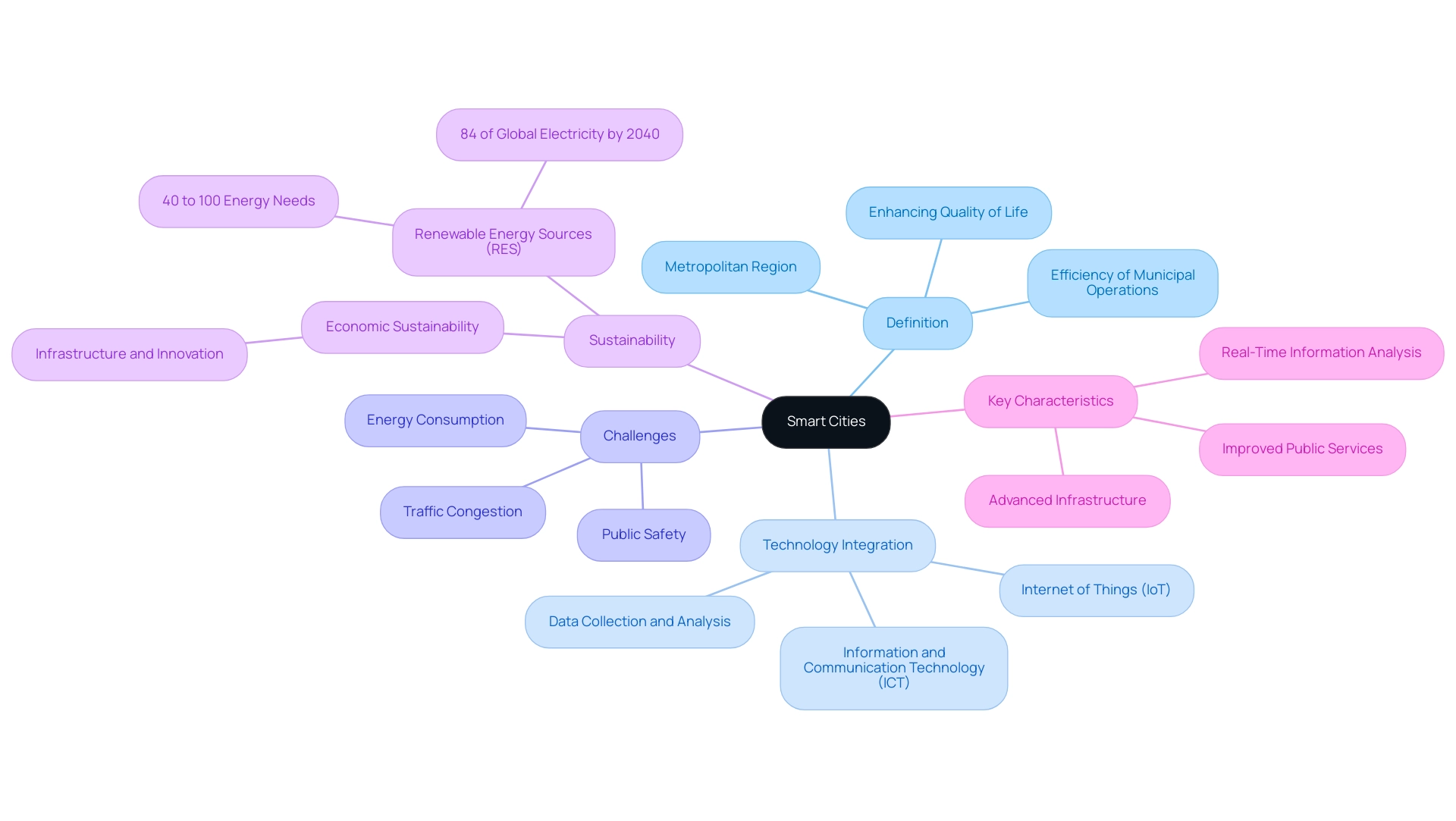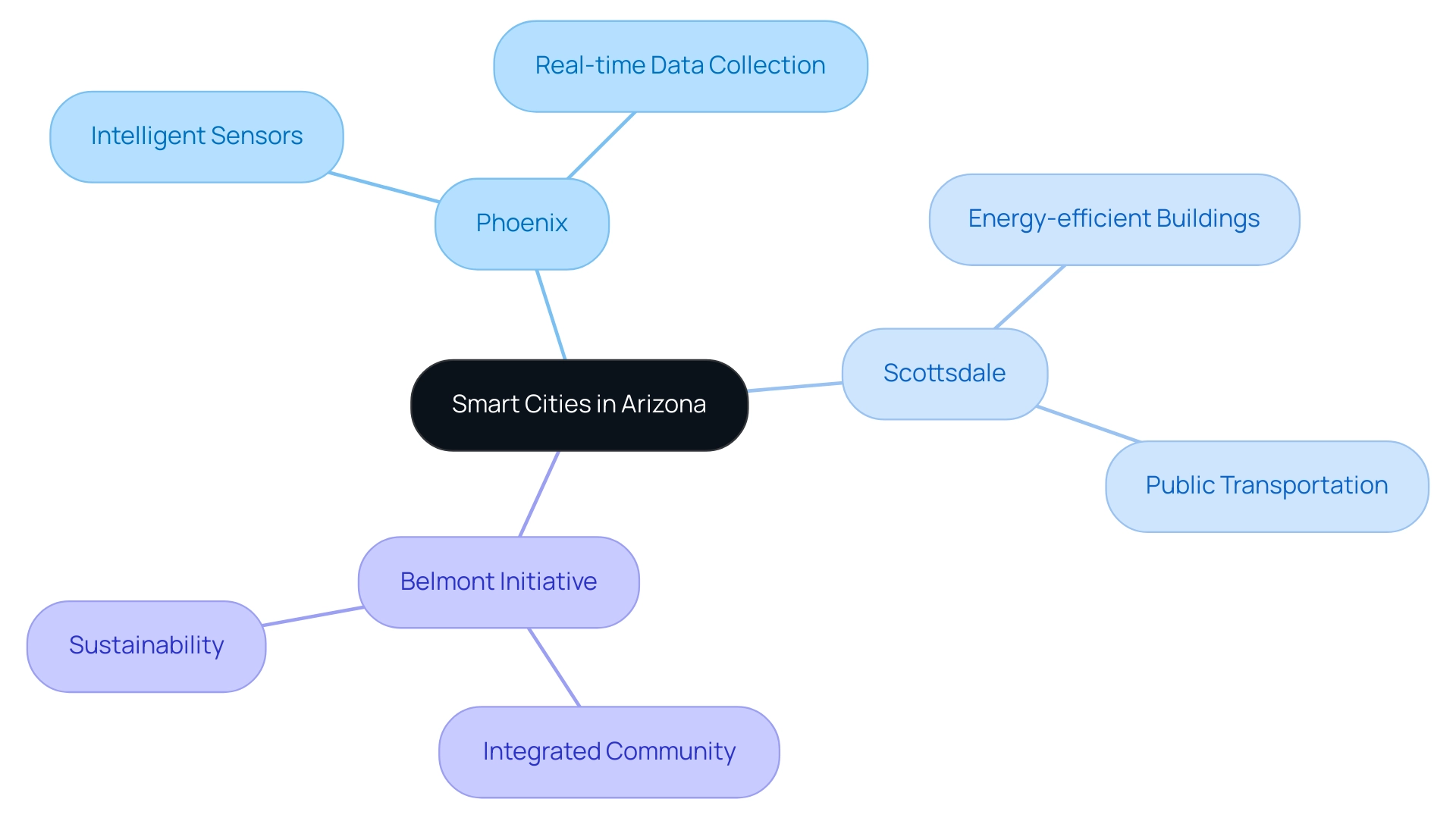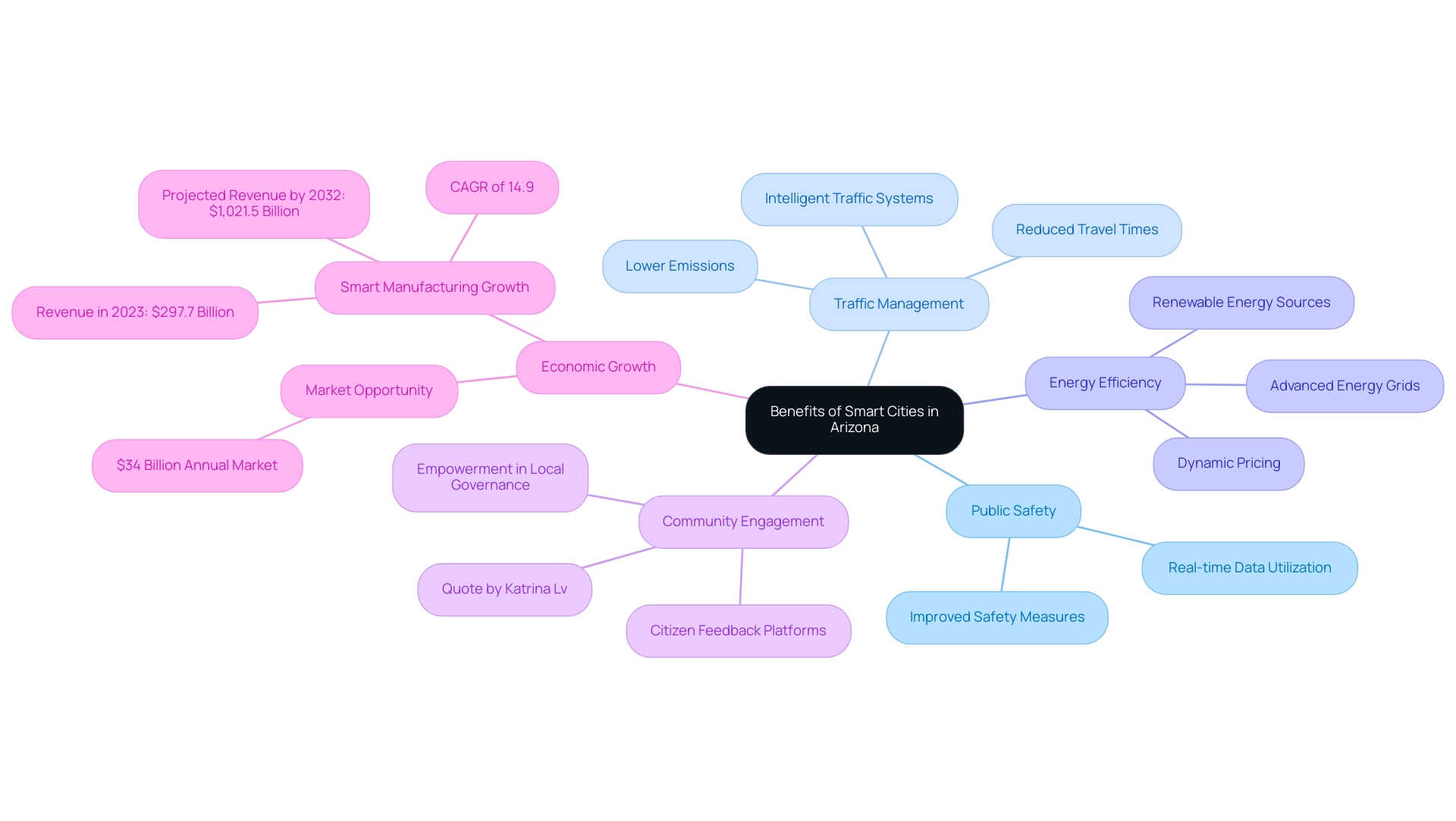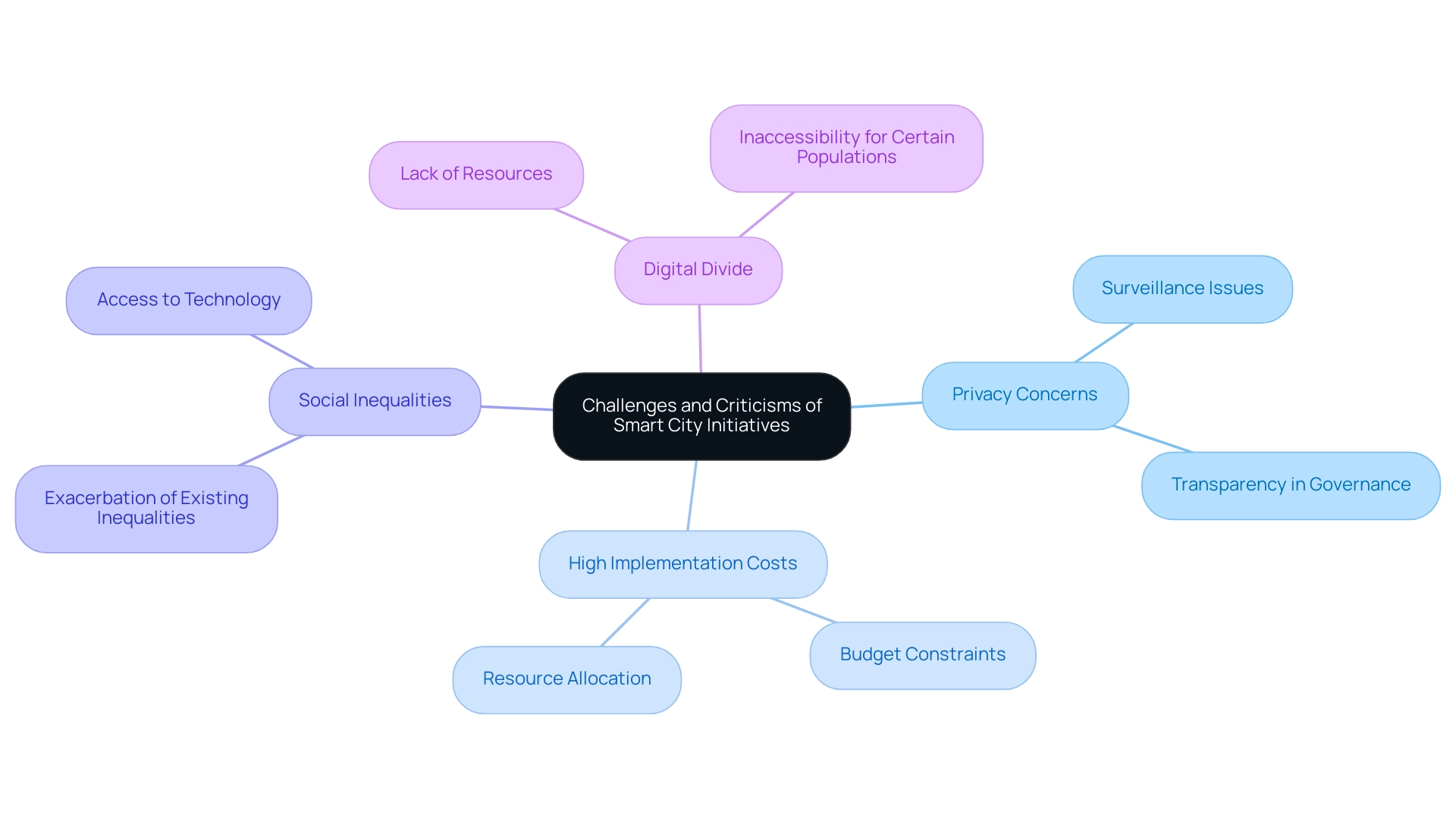Overview
A smart city in Arizona employs digital technology and data analytics to enhance the quality of life for its residents while improving municipal operations, with a strong emphasis on sustainability and efficiency. This article underscores how initiatives in cities like Phoenix and Scottsdale harness advanced technologies, such as IoT and AI, to tackle urban challenges. These efforts optimize resource management and foster community engagement, ultimately striving to create more livable and resilient environments. As these cities continue to innovate, the implications for urban living become increasingly significant, inviting stakeholders to consider the transformative potential of smart technologies in real estate investment strategies.
Introduction
In the quest for urban innovation, smart cities stand as a beacon of hope, poised to enhance the quality of life in urban areas. By harnessing digital technology and data analytics, cities are evolving into interconnected ecosystems that tackle pressing challenges, including:
- Traffic congestion
- Energy consumption
- Public safety
This article explores the multifaceted realm of smart cities, focusing on Arizona's pioneering initiatives that seamlessly blend advanced technologies with sustainable practices. From the integration of the Internet of Things (IoT) to the application of artificial intelligence in urban planning, this exploration reveals how these innovations are reshaping urban living and fostering community engagement. As cities continue to evolve, grasping the benefits, challenges, and future trends of smart city development is essential for residents, investors, and policymakers alike.
Defining Smart Cities: An Overview
A smart city in Arizona is defined as a metropolitan region that leverages digital technology and analytics to enhance residents' quality of life and improve the efficiency of municipal operations. This transformation is realized through the integration of information and communication technology (ICT) and the Internet of Things (IoT), enabling the collection and analysis of data from diverse sources, including citizens, devices, and infrastructure. The primary objective is to foster a sustainable, efficient, and livable urban environment.
Intelligent communities, such as a smart city in Arizona, confront pressing challenges like traffic congestion, energy consumption, and public safety by implementing innovative solutions that boost connectivity and data-driven decision-making. For example, urban areas that utilize renewable energy sources (RES) have reported that these can meet 40% to 100% of their energy needs, demonstrating a commitment to sustainability. Projections indicate that by 2040, RES will account for 84% of global electricity generation, underscoring the importance of integrating sustainable practices into metropolitan planning.
Economic sustainability in intelligent environments focuses on maintaining competitive regions through infrastructure and innovation, which is particularly relevant for real estate investors seeking to understand market dynamics. Key characteristics of a smart city in Arizona include advanced infrastructure, real-time information analysis, and improved public services, all contributing to enhanced urban living. As Errichiello and Micera have noted, culture is viewed merely as a component of the broader social dimension in the literature, highlighting the societal factors critical to intelligent urban development.
Successful initiatives worldwide showcase the effective use of ICT and IoT to create adaptive environments that respond to residents' needs. Moreover, the commitment to data integrity and distinct sourcing strategies, as demonstrated by Zero Flux, emphasizes the importance of reliable information in grasping advanced urban developments. As metropolitan areas continue to evolve, the role of technology in shaping intelligent communities becomes increasingly vital, paving the way for improved living standards and sustainable growth.

Smart Cities in Arizona: Unique Characteristics and Initiatives
Arizona stands at the forefront of innovation in smart city development, with significant projects underway in metropolitan areas such as Phoenix, Scottsdale, and Mesa. These regions are embracing advanced technologies to enhance infrastructure and improve residents' quality of life. For example, Phoenix has initiated the integration of intelligent sensors designed to monitor air quality and traffic flow, facilitating real-time data collection and enabling informed decision-making for city planning.
Scottsdale exemplifies a commitment to merging traditional infrastructure with cutting-edge technology, focusing on energy-efficient buildings and enhanced public transportation options. This initiative aspires to cultivate a sustainable urban environment that prioritizes the well-being of its citizens.
Additionally, the ambitious Belmont initiative, backed by Bill Gates, aims to revolutionize metropolitan living by establishing a fully integrated intelligent community. This development will leverage state-of-the-art technology to promote sustainability and livability, serving as a model for future urban environments.
As of 2025, Arizona's smart city initiatives are not only transforming local landscapes but also setting a precedent for other regions. The collaboration among local organizations and the implementation of transparent information management strategies are crucial for navigating the complexities of these projects, ensuring they address the evolving needs of the community. Thad Miller, former Co-Director, highlights the significance of resilience in infrastructure, stating, "6 rules for infrastructure resilience in the wake of Hurricane Harvey," emphasizing the necessity for robust planning in these initiatives.
With over 30,000 subscribers to Zero Flux, the demand for accurate and timely information regarding these developments underscores the importance of staying informed about transformative initiatives, particularly for real estate investors eager to capitalize on emerging opportunities.

The Role of Technology in Smart City Development
Technology is at the forefront of developing a smart city in AZ, with innovations such as the Internet of Things (IoT), artificial intelligence (AI), and large-scale analytics revolutionizing infrastructure and services. IoT devices play a pivotal role in collecting real-time data on various parameters, including traffic patterns, energy usage, and environmental conditions. This data empowers city planners to make informed decisions that enhance urban living.
AI is essential in processing the vast amounts of information gathered from IoT devices, optimizing resource distribution, and improving public services like waste management and emergency response. For example, AI algorithms can forecast peak traffic periods, facilitating better traffic management and alleviating congestion.
Furthermore, advancements in communication technologies, particularly the deployment of 5G networks, are set to transform the concept of a smart city in AZ. The number of satellite IoT connections is projected to surge from six million to 22 million between 2022 and 2027, driven by improved satellite integration. This increase will provide urban areas with enhanced connectivity and faster data transmission. As chief analyst Satyajit Sinha notes, "The integration of IoT elements is crucial for the development of intelligent urban areas, allowing them to utilize information for enhanced planning of urban environments."
As cities become more interconnected, the importance of data security and privacy is paramount. Robust cybersecurity measures are vital to safeguarding sensitive information and maintaining public trust. The anticipated dominance of licensed Low Power Wide Area (LPWA) technologies, such as NB-IoT, in the IoT landscape is particularly relevant for applications like smart meters and infrastructure management.
A recent case study reveals that the proportion of connected IoT devices utilizing licensed LPWA technologies has surpassed that of unlicensed LPWA, highlighting the growth and significance of these technologies in intelligent urban applications.
By 2025, the influence of IoT and AI in smart locations will be even more pronounced, with numerous applications enhancing metropolitan infrastructure. Case studies illustrate successful implementations of these technologies, showcasing their potential to foster more efficient, sustainable, and livable urban environments. Experts emphasize that the synergy between IoT and AI is critical for the future of a smart city in AZ, ensuring that communities can adapt to the demands of modern living.
Benefits of Smart Cities: Enhancing Urban Life
A smart city in Arizona presents a transformative approach to urban living, delivering a myriad of benefits that significantly enhance residents' quality of life. Key advantages of developing a smart city in Arizona include:
- Improved public safety
- Reduced traffic congestion
- Heightened energy efficiency
For instance, intelligent traffic management systems leverage real-time data to optimize traffic flow, effectively minimizing travel times and lowering emissions. This technology not only alleviates congestion but also contributes to safer road conditions, as evidenced by various implementations across urban areas.
Moreover, the integration of advanced energy grids facilitates more efficient management of energy resources, resulting in lower utility expenses for residents. These grids support the utilization of renewable energy sources and enable dynamic pricing, which can lead to substantial savings.
The impact of smart technologies in a smart city in Arizona extends beyond infrastructure; they also foster community engagement by providing platforms for citizen feedback and participation in local governance. As Katrina Lv, a partner in the Shenzhen office, asserts, "There are many blank canvases for the private sector, not for profits, and technologists to fill—and above all, individuals should be empowered to shape the future of the places they call home." This participatory approach empowers individuals to influence the development of their community environments, fostering a sense of ownership and responsibility.
Statistics underscore the increasing significance of intelligent urban areas, with the annual market opportunity for advanced city IT expected to reach $34 billion. This investment mirrors a broader trend towards creating a smart city in Arizona that prioritizes the needs of its inhabitants. Furthermore, the substantial growth in the intelligent manufacturing segment, which generated $297.7 billion in revenue in 2023 and is projected to rise to $1,021.5 billion by 2032, showcases a compound annual growth rate of 14.9%.
This growth not only emphasizes the economic advantages of intelligent technologies but also their essential role in promoting advanced urban initiatives. In summary, a smart city in Arizona is designed to cultivate a more sustainable and livable environment, leveraging technology to enhance urban life and empower residents.

Challenges and Criticisms of Smart City Initiatives
Smart initiatives promise numerous benefits, yet they encounter significant challenges and criticisms. Foremost among these are privacy concerns, high implementation costs, and the potential to exacerbate existing social inequalities. Critics argue that an increased reliance on technology can lead to heightened surveillance and diminished transparency in governance.
A recent analysis of intelligent urban developments in South Korea illustrates this duality. While these projects have improved equality and citizen participation, they have also raised alarms regarding transparency and privacy issues, particularly about how data is collected and utilized.
Moreover, the digital divide presents a critical challenge; certain populations may be left behind, unable to access the advantages offered by advanced urban technologies. A report highlights that cities often cite a lack of resources, experience, and capacity as primary obstacles in addressing these innovative urban challenges, as noted by Borghys. This underscores the necessity of thorough planning and community involvement to ensure equitable access to intelligent urban resources.
Case studies further exemplify these challenges. For instance, Paris has invested significantly in its transportation infrastructure since 2010, achieving a remarkable 40% reduction in traffic fatalities. However, as the municipality prepares to allocate 100 million euros for improvements aimed at connected and autonomous vehicles, it must also navigate the complexities of public trust and information privacy—critical factors for the success of such initiatives.
As intelligent urban projects continue to proliferate, particularly in developing regions projected to capture a 20% market share by 2025, addressing these multifaceted challenges will be crucial. Engaging with communities and emphasizing data integrity will be vital to building trust and ensuring that the benefits of intelligent urban initiatives are accessible to all.

The Future of Smart Cities in Arizona: Trends and Predictions
The future of intelligent communities in Arizona shines brightly, with substantial progress anticipated in the development of smart cities through innovative projects and initiatives designed to enhance metropolitan life. As urban areas increasingly embrace advanced technologies, several key trends are emerging in the context of smart cities in Arizona. Notably, the integration of artificial intelligence (AI) in urban planning is set to revolutionize the design and management of environments.
By 2025, AI is expected to be instrumental in optimizing resource allocation, improving traffic management, and enhancing public safety, ultimately fostering more efficient urban environments. Steve Zylstra highlighted that the introduction of AI has ignited discussions regarding its impact on employment, stating, "No doubt your introduction to AI happened not that long ago with a scare story about how it would take all of our jobs."
Sustainability remains a central focus, with municipalities like Scottsdale mandating the International Green Construction Code for commercial projects. This initiative not only promotes eco-friendly building practices but also inspires other cities across Arizona to adopt similar measures, reinforcing the state's commitment to sustainable development. Furthermore, Bill Gates' investment of $80 million in 25,000 acres of land near Buckeye underscores the potential for real estate investment within the framework of intelligent urban developments.
Moreover, citizen engagement is being revolutionized through digital platforms that enhance communication between residents and local governments. This increased interaction empowers communities, enabling them to actively participate in decision-making processes that impact their neighborhoods.
Public-private partnerships are also poised to play a vital role in fostering innovation and investment in solutions for smart cities in Arizona. As evidenced by the state's strategic investments in semiconductor manufacturing, data centers, and broadband expansion, Arizona is positioning itself as a leader in sustainable, technology-driven development, with the goal of creating smart cities. The case study titled "Arizona's Vision for a Technologically Advanced Future" illustrates these efforts, showcasing how investments enhance residents' quality of life while addressing critical issues such as transportation needs and the digital divide.
Additionally, Steve Zylstra emphasized that clean energy is about empowering communities, noting that it transcends solar panels and electric vehicles, referencing federal investments in Arizona's clean energy future.
In summary, the convergence of AI, sustainability initiatives, and collaborative efforts among various sectors is shaping the future of smart cities in Arizona. As these trends continue to evolve, they promise to create inclusive, resilient, and sustainable environments that benefit both residents and investors alike.
Community Engagement and Governance in Smart City Development
Community involvement stands as a cornerstone of intelligent urban development, placing residents' perspectives at the heart of decision-making processes. Effective governance models prioritize transparency and inclusivity, empowering citizens to actively shape their urban environments. Various strategies—including public forums, surveys, and digital platforms—facilitate meaningful dialogue between city officials and residents, fostering a sense of ownership and accountability within the community. This engagement is crucial for the success of initiatives related to a smart city in AZ.
As Putnam notes, citizen engagement encompasses activities related to group membership and democratic participation, underscoring its vital role in nurturing a vibrant civic life. For instance, the Framework for Community Engagement Test (CET) has been developed to assess the effectiveness of community involvement programs. By integrating social network analysis (SNA) data and survey results, the CET framework quantifies community engagement levels, revealing high participation rates and satisfaction among residents.
This framework serves as an essential tool for urban planners and policymakers, enabling them to refine their community engagement strategies. Moreover, current methods of citizen participation in urban planning are evolving, with a focus on co-creating public value. This shift acknowledges citizens as active participants in addressing local challenges, thereby enhancing the overall competitiveness and efficiency of the smart city in AZ. As highlighted by specialists in the sector, merging corporate and community strategies is crucial for nurturing a balanced governance model that promotes transparency and inclusivity in intelligent urban initiatives.
Furthermore, recent research emphasizes the importance of citizens as active agents in solving local problems and co-creating public value within smart city initiatives in AZ. This reinforces the necessity for robust community engagement strategies.

Conclusion
The exploration of smart cities underscores a transformative approach to urban living, particularly through Arizona's innovative initiatives. By integrating digital technology, data analytics, and sustainable practices, cities are not only addressing critical challenges such as traffic congestion, energy consumption, and public safety but are also enhancing the overall quality of life for residents. The successful implementation of smart technologies like IoT and AI illustrates their potential to optimize urban infrastructure and services, resulting in more efficient and sustainable city environments.
However, the journey toward fully realizing smart city potentials is fraught with challenges. Data privacy concerns, implementation costs, and social equity issues must be addressed to ensure that the benefits of smart city initiatives are accessible to all community members. Engaging citizens and fostering transparent governance are essential in building trust and ensuring that these projects reflect the needs and aspirations of the communities they serve.
Looking ahead, the future of smart cities in Arizona appears promising. Trends in AI adoption, sustainability efforts, and enhanced community engagement will shape the urban landscape, fostering inclusive and resilient environments. As collaboration between public and private sectors evolves, the potential for innovation and investment in smart city solutions will undoubtedly increase, paving the way for a brighter, more connected future. The commitment to leveraging technology for the benefit of residents reinforces the central message that smart cities are not merely about infrastructure but about cultivating vibrant communities where individuals can thrive.




